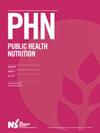从加拿大艾伯塔省 2 型糖尿病患者和家庭粮食不安全经历的角度探讨健康食品奖励计划的预期可接受性
IF 3
3区 医学
Q2 NUTRITION & DIETETICS
引用次数: 0
摘要
目标:FoodRx是一项为期12个月的健康食品处方激励计划,针对2型糖尿病(T2DM)患者和有家庭食品不安全经历的人。在本研究中,我们旨在探索潜在用户对 FoodRx 激励计划的设计和实施的预期可接受性(使用计划前的可接受性),并确定影响预期可接受性的因素。设计:我们采用了定性描述法和目的性抽样法来招募对使用FoodRx激励措施感兴趣或不感兴趣的个人。在 "可接受性理论框架 "的指导下进行了半结构化访谈,并在社会生态模型的指导下使用差异化定性分析对相应的访谈记录进行了分析。环境:居住在加拿大艾伯塔省的个人。参与者15 名患有 T2DM 并有家庭食物不安全经历的成年人。结果有兴趣使用FoodRx激励机制的人(10人)比没有兴趣的人(5人)更容易接受。我们确定了四个主题来反映影响用户预期可接受性的因素:i) 参与者对FoodRx设计和提供及其未来使用的信心、观点和信念(个人内部);ii) 参与者社交网络中个人的购物习惯和角色(人际关系);iii) 食品零售店的使用途径和经验(社区);iv) 收入和食品获取支持,以应对生活成本(政策)。结论:未来的健康食品处方计划应考虑社会生态模型各个层面的因素如何影响计划的可接受性,并利用这些数据为计划的设计和实施提供信息。本文章由计算机程序翻译,如有差异,请以英文原文为准。
Exploring the prospective acceptability of a healthy food incentive program from the perspective of people with type 2 diabetes and experiences of household food insecurity in Alberta, Canada
Objective: FoodRx is a 12-month healthy food prescription incentive program for people with Type 2 diabetes (T2DM) and experiences of household food insecurity. In this study, we aimed to explore potential users’ prospective acceptability (acceptability prior to program use) of the design and delivery of the FoodRx incentive and identify factors influencing prospective acceptability. Design: We used a qualitative descriptive approach and purposive sampling to recruit individuals who were interested or uninterested in using the FoodRx incentive. Semi-structured interviews were guided by the Theoretical Framework of Acceptability and corresponding interview transcripts were analyzed using differential qualitative analysis guided by the socioecological model. Setting: Individuals living in Alberta, Canada. Participants: 15 adults with T2DM and experiences of household food insecurity. Results: People who were interested in using the FoodRx incentive (n=10) perceived it to be more acceptable than those who were uninterested (n=5). We identified four themes that captured factors that influenced users’ prospective acceptability: i) participants’ confidence, views, and beliefs of FoodRx design and delivery and its future use (intrapersonal), ii) the shopping routines and roles of individuals in participants’ social networks (interpersonal), iii) access to and experience with food retail outlets (community), and iv) income and food access support to cope with the cost of living (policy). Conclusion: Future healthy food prescription programs should consider how factors at all levels of the socioecological model influence program acceptability and use these data to inform program design and delivery.
求助全文
通过发布文献求助,成功后即可免费获取论文全文。
去求助
来源期刊

Public Health Nutrition
医学-公共卫生、环境卫生与职业卫生
CiteScore
6.10
自引率
6.20%
发文量
521
审稿时长
3 months
期刊介绍:
Public Health Nutrition provides an international peer-reviewed forum for the publication and dissemination of research and scholarship aimed at understanding the causes of, and approaches and solutions to nutrition-related public health achievements, situations and problems around the world. The journal publishes original and commissioned articles, commentaries and discussion papers for debate. The journal is of interest to epidemiologists and health promotion specialists interested in the role of nutrition in disease prevention; academics and those involved in fieldwork and the application of research to identify practical solutions to important public health problems.
 求助内容:
求助内容: 应助结果提醒方式:
应助结果提醒方式:


